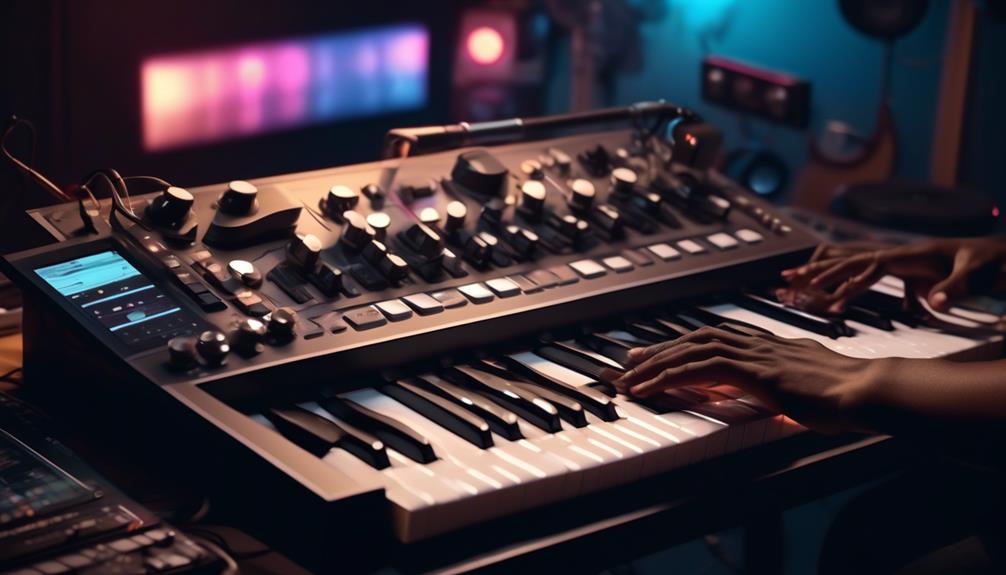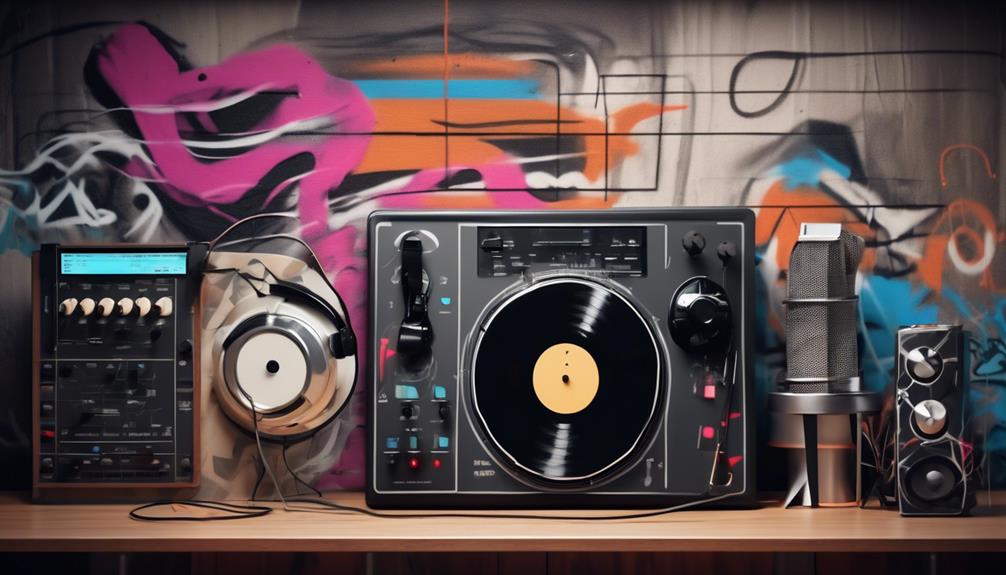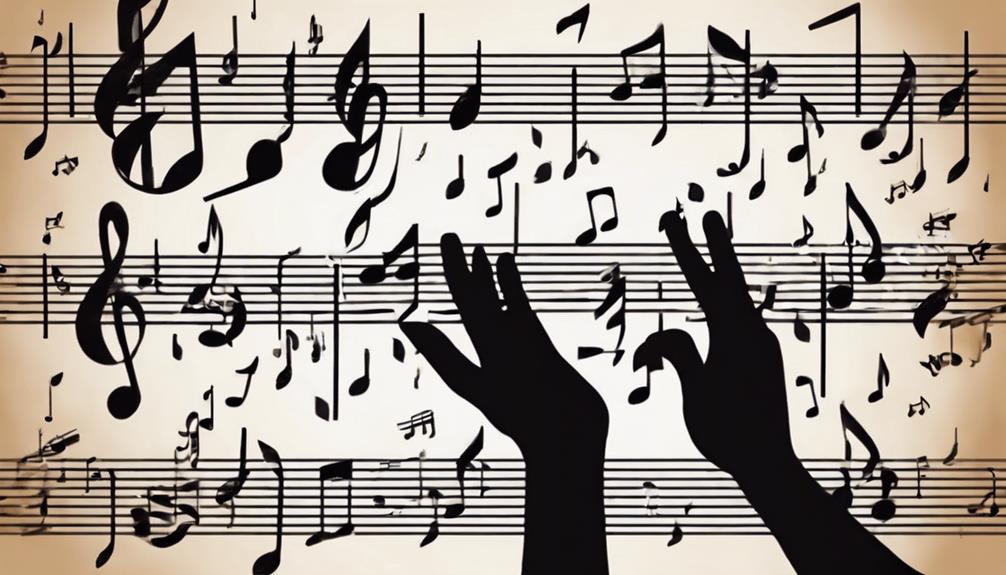No products in the cart.
As you stand at the crossroads of rhythm and poetry, the world of hip hop production unfolds before you, a landscape rich with the potential for sonic innovation. You’re aware that a masterful producer is both an architect and an alchemist, deftly blending beats, bars, and basslines to forge auditory gold.
In your hands, the basic tools of music theory transform into the building blocks of beat-making; understanding time signatures, scales, and chord progressions isn’t just academic—it’s the difference between a track that thumps and one that fizzles.
Yet, as you peel back the layers of hip hop’s rhythmic tapestry, you’ll find that there’s more to this craft than meets the ear. What secrets do these beats hold, and how can they be harnessed to elevate your next production from mere sound to a movement?
Stay tuned as we unpack the essentials of hip hop production theory, and you’ll discover that the answer lies in the very foundations of the music itself.
Key Takeaways
- Time signatures play a crucial role in the rhythmic structure of hip hop tracks, and exploring unconventional time signatures adds innovation and distinctiveness.
- Mastering notes and pitch exploration enhances the melodic and harmonic dimensions of hip hop, and experimenting with different scales and modes sets the mood and adds flair to the sound.
- Interval recognition is pivotal for creating nuanced soundscapes in hip hop music, and analyzing favorite tracks helps understand how intervals function within different harmonic contexts.
- Chord construction and progressions are fundamental in hip hop production, and understanding the interplay between major and minor tonalities and experimenting with non-traditional chord shapes can add depth and complexity to compositions.
Understanding Beats and Bars
To grasp the skeleton of hip hop production, you must first understand that each bar is a structured sequence of beats, providing the rhythm and pacing essential to the genre’s flow. This framework is where your mastery begins; beats and bars form the grid on which musical elements are plotted. Time signatures serve as a blueprint, dictating how many beats fill a bar and which note value is deemed a single beat.
You’ll employ counting techniques to navigate this soundscape, a metronome ticking in your mind. It’s a numerical dance – one, two, three, four – each count a step in the choreography of rhythm. By internalizing this cadence, you become attuned to the rhythmic patterns that are the heartbeat of hip hop.
Dive into the intricacies by exploring varying time signatures. A standard 4/4 time might be your starting block, but don’t shy away from the uncommon. Disrupt the norm with a 3/4 waltz or an asymmetrical 5/4 beat, injecting your tracks with a dose of innovation that’ll set heads nodding in unexpected ways.
In hip hop production, counting isn’t just arithmetic; it’s an art form, where numbers paint sounds and silence in between.
Time Signature Essentials
Understanding time signatures is crucial as they anchor the rhythmic structure of your hip hop tracks, guiding you through the creation of compelling beats and grooves. While 4/4 is the standard bearer for its straightforward pulse, don’t confine your creativity to this common pattern. Exploring unconventional time signatures can catapult your sound into a new dimension, where rhythm becomes a playground for innovation.
Consider these benefits of using odd time signatures in hip hop production:
- Unpredictability: Odd time signatures like 5/4 or 7/8 introduce an element of surprise, keeping listeners engaged and on their toes.
- Complexity: These signatures demand a higher level of attention and can showcase your technical prowess as a producer.
- Distinctiveness: They set your work apart, creating a unique sonic identity that can define your artistic brand.
Dive into the realm of irregular meters to craft beats that defy expectations. Embrace the challenge of blending syncopated rhythms with the lyrical flow of hip hop. The result? A fresh, standout track that pushes the boundaries of genre and keeps the hip hop scene evolving.
Notes and Pitch Exploration

While mastering time signatures provides a rhythmic foundation, honing your skills in notes and pitch exploration will elevate the melodic and harmonic dimensions of your hip hop productions. Exploring melodies isn’t just about hitting the right notes; it’s about delving into the emotional spectrum of your music. Creating harmonies, on the other hand, is akin to painting with a broader palette, enriching your tracks with layers that resonate with your listeners.
To innovate, you’ll need to manipulate scales and modes to set the mood. For instance, a minor scale might evoke a somber tone, while the use of a mode like Dorian can introduce a distinctive flair to your sound. Experiment with different intervals to see how they alter the vibe of your beat.
Here’s a table outlining various approaches to notes and pitch exploration:
| Scale/Mode | Mood/Tonality | Use Case in Hip Hop |
|---|---|---|
| Minor | Somber, Dark | Emotional storytelling |
| Major | Uplifting, Happy | Anthems, Party tracks |
| Dorian | Mysterious, Soulful | Lo-fi, Chill beats |
| Phrygian | Exotic, Tense | Hard-hitting tracks |
| Mixolydian | Groovy, Relaxed | Funk-influenced grooves |
Interval Recognition Techniques
Mastering interval recognition techniques empowers you to discern the distinct musical distances between notes, a skill that’s pivotal for crafting the nuanced soundscapes that define hip hop music. The importance of interval recognition can’t be overstated; it’s the backbone of innovative sound creation, allowing you to construct chords, melodies, and basslines that resonate with your audience’s emotions and expectations.
Here are some strategies to sharpen your interval recognition:
- Regular Ear Training Exercises: Engage in daily practice sessions using apps or online tools designed to drill various intervals. As you gradually improve, your ability to identify intervals in samples and loops becomes almost instinctual.
- Analytical Listening: Take time to analyze your favorite hip hop tracks. Deconstruct them to understand how the intervals contribute to the overall vibe. This analytical approach deepens your comprehension of how intervals function within different harmonic contexts.
- Creative Experimentation: Don’t shy away from experimenting with unconventional intervallic combinations in your own productions. Pushing the boundaries of traditional hip hop harmonies can lead to fresh and original sounds.
Scales and Modes Application


You’re now at the crossroads of emotion and theory, where your choice of scale or mode sets the tone for your hip-hop track.
Selecting the right pattern of notes can elevate your melody, imbuing it with a distinct mood, be it melancholic minor or an uplifting major vibe.
Harness these musical frameworks creatively, and you’ll carve out a sonic identity that’s uniquely yours in the beat-making landscape.
Choosing Hip Hop Scales
To capture the essence of hip hop, it’s crucial to choose scales and modes that reflect the genre’s emotional depth and urban edge. You’re not just laying down beats; you’re crafting a narrative. Here’s how:
- Embrace Melodic Variation: The importance of melodic variation can’t be overstated. It keeps your tracks dynamic and engaging.
- Explore Unconventional Scales: Using unconventional scales in hip hop production can set your sound apart, infusing your tracks with originality and a fresh perspective.
- Analyze Genre Staples: Dive into minor pentatonic and major blues scales—hip hop mainstays that evoke the raw emotionality central to the genre.
Your technical prowess and creative innovation must come together as you choose your scales. It’s this blend that will give your music the innovative edge that the audience desires.
Modes in Beat Making
As you refine your scale selection, consider how integrating modes like Dorian and Phrygian can elevate your beats, infusing them with nuanced emotions and originality. Dorian mode, with its jazzy and somewhat melancholic vibe, can inject a sense of soulful introspection into your tracks.
Phrygian, on the other hand, brings an exotic, sometimes ominous feel, ideal for crafting beats with a darker edge.
Exploring tonalities through these modes isn’t just about adding variety; it’s about creating emotional impact. Your understanding of Mixolydian’s cheerful groove or the mellow richness of Aeolian allows you to paint intricate sonic landscapes.
Each mode is a tool, empowering you to design harmonically complex and emotionally charged compositions that captivate your listeners and set your beats apart.
Chord Construction Basics
As you construct chords, remember that the interplay between major and minor tonalities is foundational to the emotional resonance of your tracks.
Analyzing chord progressions reveals the structural backbone of hip hop anthems, guiding the listener’s journey through your sonic landscape.
When sampling or crafting chord loops, your technical savvy in chord construction will be pivotal in layering depth and complexity into your music.
Understanding Chord Progressions
Delving into chord progressions requires a solid grasp of chord construction fundamentals, the building blocks that create the backbone of any hip hop production. You’ll need to understand how chord voicing techniques and harmony layering principles can dramatically alter the emotional impact of your tracks.
Here’s how you can innovate:
- Explore various chord voicings to add depth and complexity to your harmonies.
- Experiment with non-traditional chord shapes to find unique sounds.
- Utilize harmony layering to build tension and release throughout your composition.
Major Vs. Minor Chords
Understanding the distinction between major and minor chords is crucial, as they serve as the foundation for the emotional landscape of your hip hop productions. Major chords, created from the 1st, 3rd, and 5th notes of a major scale, exude a sound that’s bright and happy. They convey consonance and stability, perfect for crafting tracks with an uplifting or triumphant vibe.
In contrast, minor chords—formed from the 1st, flatted 3rd, and 5th notes—cast a darker, sadder tone, embodying melancholy and introspection.
When you’re weaving together major vs. minor chord progressions, you’re essentially manipulating the emotional impact of your beats. Harnessing these nuances allows you to sculpt the auditory narrative, transitioning seamlessly between feelings of joy and sorrow to engage and resonate with your listeners.
Sampling and Chord Loops
Exploring the realm of hip hop production, you’ll find that sampling chord loops not only simplifies chord construction but also injects a sense of musical history into your tracks. When delving into this technique:
- Chord Progression Manipulation: You’re not just looping chords; you’re reimagining them. Manipulate tempo, pitch, and rhythm to invent a fresh backdrop for your lyrical poetry.
- Incorporating Samples in Beat Making: Dig deep into crates of old records to find those gems—soulful progressions that resonate with listeners’ subconscious.
- Building Innovative Harmonies: Use your knowledge of scales and intervals to layer additional sounds, creating a complex tapestry that captivates and holds.
Crafting Chord Progressions
To craft compelling chord progressions in hip hop, you must thoughtfully select and sequence chords that evoke the desired emotional response and drive the harmonic narrative of your track. Delve into chord progression techniques to understand the emotional impact of chords. Major chords often bring a bright, optimistic tone, while minor chords can convey a more somber or introspective mood. Augmented and diminished chords add tension and complexity, pushing your track’s emotional boundaries.
Experiment with various chord types to innovate and refresh your sound. Hip hop thrives on innovation, so don’t shy away from blending unconventional chords to create a signature vibe. Familiarize yourself with popular hip hop progressions, like the two-five-one, and manipulate them with inversions and voicings to craft a unique soundscape.
Here’s a table to guide your exploration:
| Chord Type | Common Use | Emotional Impact |
|---|---|---|
| Major | Uplifting | Optimistic |
| Minor | Reflective | Melancholic |
| Augmented | Tension | Unstable |
| Diminished | Transition | Dissonant |
Rhythm and Groove Fundamentals


While crafting chord progressions sets the harmonic tone, it’s the rhythm and groove that truly bring your hip hop track to life, dictating its feel and movement. To master this, you need to dive into the intricacies of rhythm and groove fundamentals.
Here’s what you need to focus on:
- Beat Structure Mastery: Understanding the backbone of your beat is essential. You’re working with layers of sound that must interlock perfectly. Start by getting comfortable with standard time signatures and then push the boundaries with rhythmic experimentation, adding unexpected elements that challenge the norm.
- Innovative Groove Variations: Don’t let your beats become monotonous. Incorporate groove variations to keep listeners on their toes. This could mean alternating between straight and swung rhythms or introducing subtle changes in your drum patterns to create a dynamic listening experience.
- Rhythmic Techniques: Experiment with syncopation, ghost notes, and polyrhythms. These techniques can add depth and complexity to your groove, making your track stand out. The goal is to create a rhythm that not only supports the harmony but also makes the listener feel the beat in their core.
Frequently Asked Questions
What Are the Basics of Hip Hop Production?
You’ll need to master beat sampling and drum programming to innovate in hip hop production, blending creativity with technical skill to craft unique rhythms that resonate with your forward-thinking audience.
What Is the Basic Music Production Theory?
You’ll need to grasp beat sampling and sound layering to innovate in music production. They’re crucial for crafting unique tracks that resonate with your audience, blending creativity with technical skill.
What Does Production Mean in Hip-Hop?
In hip-hop, production’s your craft of beat sampling and sound layering to architect a track’s foundation. It’s blending creativity with tech to innovate, ensuring each piece resonates with fresh, groundbreaking auditory experiences.
Do Hip Hop Producers Use Music Theory?
You’ll find hip hop producers often utilize music theory, particularly when beat sampling and crafting groove essentials, to push sonic boundaries and innovate within the genre’s ever-evolving soundscape.
Conclusion
Now you’ve grasped hip hop’s core—the beats, bars, and time signatures that frame your sonic canvas.
You’ve explored notes and pitches, unlocking intervals for those standout melodies.
With scales and modes at your fingertips, and chords ready to construct, you’re set to weave complex progressions.
Remember, rhythm and groove are your beat’s heartbeat.
Keep honing these skills; they’re your toolkit for crafting tracks that resonate, innovate, and elevate the hip hop landscape.




